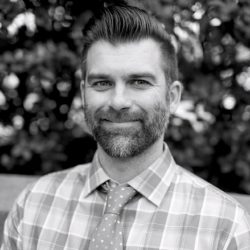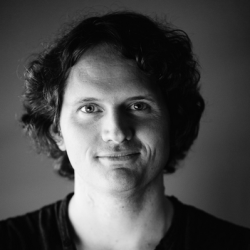
I am sitting in what could be the waiting room of any neurosurgeon’s office in the country. Trying to look “normal” and to distract myself from the searing pain in my body, I scan the room. In one corner, a man engages in an important business deal on his cell phone. I imagine him to be a powerful executive meting out daily tongue-lashings to interns and inept junior colleagues. But the forceful, even authoritative tone of his voice is belied by his posture. Whereas the volume of his rant would suggest a wildly gesticulating speaker, he barely moves. Sitting only in the most abstract sense, his back is contorted into a grotesque arch with the top of his head flat against the wall—his chair serving only as a platform where his paralyzing pain plays out.
To his left, another man has abandoned his seat altogether and is on his hands and knees, calmly attempting to read a magazine while rhythmically shifting his body back and forth to mitigate pain. The periodical he attempts to read rests serenely on the chair he is no longer able to occupy. Just then, the elevator dings and a woman in a wheelchair emerges from behind the stainless- steel doors. I do not know her, but I know the hollow look in her eyes that comes with being consumed by pain. An unyielding force appears to have swallowed her whole.
Much like my waiting room neighbors, I too suffer from chronic pain. For more than a decade now, I have been living with a degenerative disc disorder and spinal stenosis, which means that the narrowing of my spinal canal and the herniated discs in my neck radiate severe pain to my back, chest, shoulder, arm, and hand. On good days, the pain is manageable. I am able to sit at my computer, go to the gym, and even pick up my daughters with only mild discomfort. When my symptoms become slightly aggravated, sleep is elusive. I am sometimes able to manage a few hours of rest each night by carefully situating myself in “Daddy’s bed”—the name my daughter has given to the chair into which I collapse after succumbing to prescribed narcotics.
On bad days, though, the pain is unendurable. Imagine a bad muscle cramp mixed with the “pins-and-needles” sensation of an arm that has lost circulation. Then, imagine being lit on fire from the inside out. When this happens, I can neither lie down nor sit down without exacerbating the problem, so on bad nights I simply pace the hallways of my house, waiting for dawn.
I am only 37 years of age, but I feel old. In spite of numerous sympathizers who brave their fair share of sleepless nights, I also feel alone, not to mention completely broken.
Not too long ago, I experienced a particularly bad flare- up that lasted for months. I was exhausted with everything: tired of hurting, of sleepless nights, of being a burden to my wife and children. Most of all, I was tired of the world that God had made—a capricious world with a reality defined by pain I felt I could no longer endure. I resonated with Dostoyevsky’s words in The Brothers Karamazov: “It isn’t that I refuse to acknowledge God, but I am respectfully giving him back my ticket to a world like this.”
I find I have very few places where I am allowed the freedom to express this level of fear and doubt. Much like the uncertainty it produces, pain is not “normal” in the contemporary Western world. It is a sign of weakness. It is an aberration. The chronic nature of my pain also weighs down others—especially those who care for me most and urgently want to see me well. Consequently, my encounter with chronic pain, although hidden from view, is a struggle that shapes and reshapes my basic awareness of the world.
But the deeper truth—one that is as unexpected as it is daunting—is that pain does far more than simply press me into a realm of disbelief. Time and again, it ushers me into the catastrophic presence of God.
Catastrophic. Rarely are we comfortable associating a word like this with the work of God, but it captures an important element of my story. I have been shattered in more ways than one. But this shattering has opened a whole new register of meaning for me. I have encountered a depth in this life that I never knew existed. As a result, I am no longer the person I once was.
No longer will your name be Jacob . . . but Israel, because you have fought with God and with men and have prevailed. (Gen 32:28 NET)
While making plans to cross the river Jabbok, Jacob wrestles all night with Yahweh, who encounters him in the form of a man. Yahweh brings their mano-a-mano wrestling match to a close by dislocating Jacob’s hip. After receiving a new name (Israel), Jacob rightly calls the site Peniel (“face of God”) for, in his words, he had “seen God face to face and survived” (Gen 32:30). Yet, in a somewhat bizarre twist, the story simply ends with Jacob limping toward sunrise, forever reminded of his encounter with God.
I am often reminded of Jacob during my own bouts with chronic pain. When I hear others retell his story, the focus is often on Jacob’s “fresh start”—on his new name and his new outlook on life. This interpretation does make sense. After all, it feels good to think about the way Jacob went from a conniving, backstabbing brother to the father and namesake of God’s chosen people. We like that story. But it’s not the whole story, for it fails to account for the fact that God’s blessing of Jacob cannot be separated from his inescapable struggle with chronic pain.
Just like his shiny new name, Jacob’s limp paints an unsettling picture for us. On one hand, very few individuals have encountered God as intimately as Jacob did on that night. On the other hand, I would venture a guess that even fewer have lived the rest of their lives with the kind of physical, psychological, and spiritual trauma that resulted from that encounter. No one, it would seem, walks away unscathed from an encounter with God. Nevertheless, Jacob’s agonizing encounter with Yahweh has the potential for serving as a kind of icon. The nation of Israel forever memorialized Jacob’s chronic pain by avoiding meat taken from the socket of the hip (Gen 32:32). In other words, rather than attempting to “manage” or even “fix” the reality of chronic pain, the community of faith took this anguish up within its worshipping life and, in doing so, reconstituted both the pain and themselves. On a fundamental level, they became a community defined by their suffering.
I often wonder what would happen if the Christian community did the same. What if we not only created space for others to hurt/doubt/cry/flail/scream/question, but also incorporated the experience of chronic sufferers into our personal and communal forms of life? What if their stories became our story? This might not generate a great deal of certainty. But the good news is that, when it comes to being the people of God, we’re not after certainty; we’re after communion.
How difficult it is for me to fathom your thoughts about me, O God!
How vast is their sum total!
. . . Even if I finished counting them,
I would still have to contend with you. (Ps 139:17–18 NET)
Chronic pain forces me into a daunting, disturbing, life-changing, awe-full, mesmerizing, disorienting space that is inhabited by a God who cannot be contained or controlled or co-opted. There is no room in this space for a simplistic and naïve faith that glosses over contradictions and sweeps legitimate doubts under the carpet. We can only dive headlong into the darkness, protesting along the way the sheer wrongness of it all. Yet, just as the Psalmist suggests, even if we could somehow sift through all our existential angst, anger, and confusion, we would still have to contend at the end of the day with this unwieldy and untamed God—a God who not only chooses to work through pain, but a God who moves so god-awfully slow.
When my own moments of pain seem to stretch into infinity, the word “faith”—whatever it may in fact mean during times of normalcy—becomes a far more complex and even terrifying proposition. In the course of a single pain-filled hour, I have lost my faith and found it anew more than once. But that is the convoluted beauty of it. Like Jacob wrestling at the Jabbok, pain not only forces me to confront all the doubts and fears that lurk just beneath the surface of my meticulously constructed facades, it also exposes me to a depth of intimacy that doesn’t seem reachable by any other means.
In an important sense, then, regardless of what ails each of us, we all inhabit a waiting room filled with people who, just like us, suffer from a chronic condition. No human life is without pain, not even the one lived by the human who was also God. Which is exactly why, when suffering has taken us to the end of ourselves, when we are completely undone by our pain, we are able to enter a sacred space where the boundaries between heaven and earth evaporate. In that most precious of spaces, our bodies are not alleviated of pain, but re-created in and through it. And, much like Jacob, what emerges from this context is not an easy kind of painlessness, but a hard- won hope—one that weaves our chronic pain into the redemptive story that God is writing for us all.



